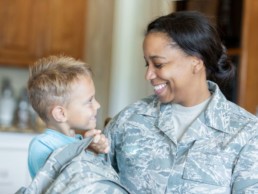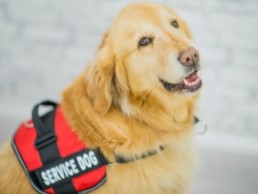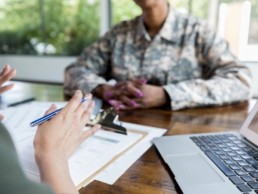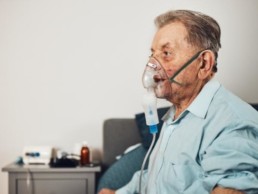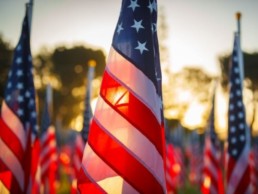Donation: Charitable PayRaise
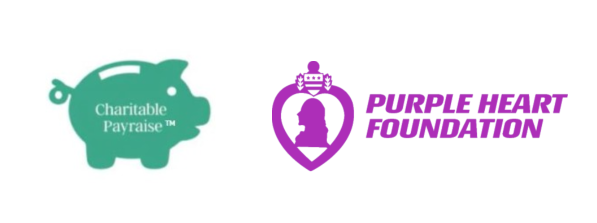
With great excitement, we would like to officially announce the strategic partnership between The Purple Heart Foundation and The Charitable Payraise®, in time for Purple Heart Day. For over 65 years, The Purple Heart Foundation has helped fund programs and services to help veterans transition to civilian life.
The Charitable Payraise® helps facilitate a planned gift and a legacy-defining bequest. The strategic partnership with The Charitable Payraise® will allow veterans, donors, and the broader community to review their retirement and giving plans to maximize their after-tax cash flow and increase their impact.
Download the brochure to learn more.
“As the son of a son of Marine Officers, it is our honor to partner with The Purple Heart Foundation to serve those who have so honorably served us. Our mission is to expand the opportunities to give to this noble cause while helping donors improve their own retirements. We hope you will inquire about this ‘Win-Win’ opportunity,” said Bill Lloyd when describing why the partnership means so much to him personally.
One of the giving options with The Purple Heart Foundation is through bequests. If you have a highly appreciated asset, such as land, stock, etc., The Charitable Payraise® can assess if your retirement cash flow and giving can be increased. They work with your financial advisor as part of the assessment. The Charitable Payraise team has created a new financial method, and with their patented approach and financial app, it is easy to see if adding them to your financial planning makes sense.
You can learn more on Charitable Payraise’s How It Works Page about their approach and how we can help.
You can also learn more at www.charitablepayraise.com. Interested in enhancing the lives of veterans everywhere? Learn more about the amazing impacts you can make at www.purplehear2dev.wpengine.com.
Our Mission
The mission of the Purple Heart Service Foundation is to enhance the quality of life of Purple Heart recipients and other honorably discharged veterans and their families.
Purple Heart Foundation's Full-Ride V-School Scholarship

The Purple Heart Foundation is proud to announce the Full-Ride Scholarship to V School, an opportunity for Purple Heart Foundation supporters and their family members. We are committed to empowering our heroes and their loved ones, providing them with the tools and resources they need to thrive in the ever-evolving world of technology, design, and innovation. In addition to the Full-Ride Scholarship, we are also offering $2,000 partial scholarships to further support our community.
Some of the things you should note are:
- There is a Full-Ride and Partial Scholarships: Apply for either 100% tuition coverage or one of the many $2,000 partial scholarships, ensuring financial support for your education.
2. Flexible Learning Options: Choose from full-time and part-time online programs, tailored to fit your unique schedule and learning preferences.
3. Comprehensive Curriculum: Master in-demand skills in fields such as web development, cybersecurity and UX/UI design.
4. Career Support: Gain access to V School's extensive network of industry partners, career coaches, and alumni, who will help you navigate the job market and secure a rewarding career.
We encourage you to take advantage of this opportunity to transform your future and make a lasting impact in the tech industry. Apply for the Purple Hearts Foundation Full-Ride Scholarship or one of the $2,000 partial scholarships to V School today! Don't miss this opportunity to transform your future and make a lasting impact in the tech industry. Apply for the Purple Hearts Foundation Full-Ride Scholarship or one of the $2,000 partial scholarships to V School today!
APPLY HERE
A Look Back At Their Walk Across America

Back in 2018, two friends, Matt Andersen & Trevor Stephens, began their journey, a “Walk Across America,” that would take a little over 6 months to raise awareness and money for a charity of their choosing. They chose that they would be walking for the Purple Heart Foundation in May 2018. They showed the power of what two people can do for the veteran community. Matt and Trevor were able to raise over $8,000 for the Purple Heart Foundation during their walk. We caught up with them to talk more in-depth about their “Walk Across America” and what they have been up to.
Thank you gentleman for taking some time to sit down and talk with us to catch up.
(Matt & Trevor): Thanks for having us. We are happy to be here talking with our friends from the Purple Heart Foundation.
Trevor, you are a veteran. How do you look back on your days on active duty?
(Trevor): Kinda like the walk, at the time it was a tough and frustrating time, and there was a lot of bad but looking back it was some of the best times of my life. It impacted me in a way that got me out of trouble. I truly believed it helped me in life in different ways.
I have a friend actually who was helped by the Purple Heart Foundation with a grant around the time we began the walk. He is doing much better and is walking with a cane. He regained most of walking with a cane. He can’t work but still does therapy and lives in North Carolina. He has a good mental mindset, he still makes jokes and has a good attitude.
Does your status as a veteran prompt you to talk about issues like veteran suicides?
(Trevor): It is important because I know a few people in connections that know others that have committed suicide. When you are in the military you know how big of a deal it is. Going through tough situations sometimes you break. There is a lot of stress so it's important to let everyone know about what is going on with our veterans.
You two are good friends from Council Bluffs, IA, but how did the walk Across America get started?
(Matt): In 2007 we met each other in middle school in Iowa. In High school we became closer friends through mutual friendships. It was Trevor's idea to do it. The road trip was scheduled after I graduated from college and Trevor came out of military duty. Trevor was watching videos of people walking long distances for music festivals in a show.
(Trevor): Going through a rabbit hole and seeing what others did to raise money for charity, I got the idea of walking across the country. I texted another friend if he wanted to walk across the country. I was not doing it by myself and texted Matt. At first he thought I was crazy. It took some convincing for Matt to finally get him to join the walk. We had brought up the idea of traveling before. Took him an hour to be set to want to do it, then 4th of July 2017 it was decided that we were going to do it.
"This is where it felt like it became bigger than us.”
It has been a little while since you did the Walk Across America, how did you both feel about doing it in the beginning? How do you feel about it now?
(Trevor): It was hard to believe that we actually did it in the end. I go back and rewatch the videos they made along the way. It was 7 months worth of videos on the road. I look back on it and it was one of the best things I have done in my life, along with joining the marine corps.
Are there any memories from the trip that stick out to you guys?
(Matt): From all kinds of people we met along the way. People took us in to have us as guests in their homes when they understood that we were supporting veterans and the Purple Heart Foundation. We met a man in Walcott, Iowa, stopped on the road when he saw us, went down the street, got food for us and came back. We ate the food in his truck. He gave us a signed book since he was a writer. I see a town somewhere and I remember and say wow I really walked through that place. People were always stopping to see us and ask what we were doing. And they loved the idea as soon as they found out and were supportive. One couple invited us to eat at a restaurant and let us stay in their home to sleep over. The Injuries we got as we walked were also memorable. Trevor's feet were hurting so bad. By the time we were in Indiana, Trevor had deep cuts in his feet and I had to find ways to help him.
This is where it felt like it became bigger than us. People said thank you and what we were doing mattered. We felt like we could not quit, it fueled us. It hit home for us. The people helping us the most and the biggest supporters all had a military connection, whether a veteran or a military family. They put us on The Chicago Tribune.
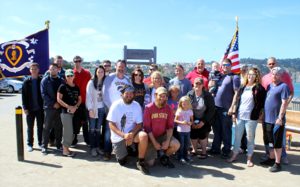
You mentioned how tough the walk was, were any states harder to walk?
(Trevor): Harder states were West Virginia by the Appalachian Mountains during the winter time. Utah was so hot I had some symptoms. I had a breakdown. Almost quit it but did not. We decided from Utah to Nevada we would walk before the sun came up.
I Lost three toenails during the walk. I wasn‘t paying attention to my body and there were days where I had heat exhaustion and dry heaving. In Nebraska, we went to see a memorial/statue and had a full body cramp. I had to get IV fluids at the VA hospital. I was still affected badly by the walk even though I was still one of the best hikers because of my experience. My Shoes were wearing out. I Had to be in a hotel for three days, had blisters, and could not walk at all. We believed our feet were gonna harden up.
How did you both feel when you finally made it to San Francisco, ending the walk?
(Trevor): Once we made it to Baker Beach, San Francisco, We definitely had mixed feelings. We were actually ahead of the scheduled timeline we made. Purple Heart Foundation had set up a little get together party for our family and friends to come to San Francisco and to celebrate with us. We couldn't believe that we made it. I remember Matt was looking over Alcatraz and taking videos of the view. That night we had a party and hung out with everyone and had a good time, walking near the ocean. We went to a bar and watched the Iowa vs Iowa State football game.
(Matt):We were so tired to comprehend that we made it. I Couldn't believe that we lived this lifestyle for such a long time and it was coming to an end. It took us 6 months and two weeks to walk across America. We started the walk on March 1st, 2018 and finished September 8th, 2018. 191 days and 3105 miles. We did not necessarily lose much weight because we were not eating the best foods while the trip occurred.
“The people helping us the most and the biggest supporters all had a military connection, whether a veteran or a military family.”
Would you do the Walk all over again?
(Matt): Now I think neither of us could handle it now. We have really thought about it for a couple of months, we want to drive through the entire trail in a car and try to see the people we met. I tell you the experience was worth it and the freedom of being outside.
We remember that you both had plans after this, we wanted to know how are you guys and what you have been up to?
(Matt): I Went to New York and became a technician and then went to paris. Staying in France for a little long but I’m thinking of coming to the U.S. but I am not sure of it. Bringing up the Walk Across America looking for a job actually has helped me in the job interviews.
(Trevor): I will be graduating soon and plan to find a job with the national parks service as a ranger.
Congratulations on your impending graduation. Is there anything you would like to share with anyone reading this?
(Both): Keep on going and help support the programs . The money is going to good places when you donate with the Purple Heart Foundation, and I remember how they helped my friends, they make sure that it goes to the right people in need of the help.
Home Buying Advice For Veterans
Our nation’s veterans receive some specific financial benefits upon their discharge from the military. It's crucial they recognize and receive the advice needed to take full advantage of these offers. Veterans can receive benefits ranging from social security to home buying perks. Below are a few important tools and strategies veteran homebuyers can familiarize themselves with to make homeownership easier.
Utilize a VA Loan
When looking to purchase a home as a veteran, accessing Veteran Affairs (VA) loan is a great place to start the process. VA loans are filled with wonderful benefits that you can take advantage of. Purchasing a home with no down payment, lower credit score requirements to be eligible for a loan, and the access to lifetime benefits are just a few of the multiple great benefits you can receive from a VA Loan.
To qualify for a VA loan from a mortgage lender, you must be a veteran, an active duty service member, or a military spouse. But those are not the only eligibility requirements to determine if you will receive a VA loan or not.
If you’re hoping to acquire a loan, some other requirements include serving 90 consecutive days during wartime or 181 days during peacetime as an active duty service member, you have served in the National Guard or Reserves for six years, or you’re the spouse of a service member who suffered a service-related disability or has died in the line of duty.
There is more than one type of VA loan that you can choose from if you meet the eligibility requirements to qualify for one. Each different type of loan depends on certain criteria including credit score, income, and other factors. Bringing in a VA loan savvy real estate agent and completing a Certificate of Eligibility (COE) online are great ways to help you determine what loan type you should go for.
Get the Proper Paperwork in Order
There is plenty of information needed to get your VA loan process underway. The previously mentioned COE, form DD-214, and other general information will be needed during the loan acquisition process.
The COE is a document created by veteran affairs that provides information that proves that you are eligible for a VA loan. It is important to complete this certificate early on in your process as it will help move everything as long as smoothly as possible. A COE can be obtained through eBenefits online.
Form DD-214 is another required document you will need to obtain in the process of acquiring a VA loan if you are currently a military veteran. It shows proof of your discharge from the military. Acquiring your DD-214 form is a straightforward process that you can do yourself or have someone else do for you.
Other common documents needed during the process include a government-issued ID, your W-2 and tax returns from the previous two years, and most recent bank statements and pay stubs. Getting all of these documents together ahead of time will help reduce the stress of the process. To further reduce any financial anxieties and streamline your search, we suggest getting pre-approval on your mortgage. The sooner the paperwork and logistics are taken care of, the sooner you can begin your search for the perfect home.
Searching for Your Home
Once you create your budget, get your loan and mortgage approved, and have all your paperwork in order, you can finally begin the house-hunting process. It’s important to take care of all of the logistical aspects of the process before beginning to look at homes to ensure that you do not fall in love with any homes that you may prove to not be a realistic purchase for you later in the process.
You must consider things such as the school district if you have kids and any taxes that come along with the school district you are located in. Depending on what state you’re looking to live in, there are some different veteran housing benefits in each state. So make sure you familiarize yourself with any potential benefits the state you are looking to live in may offer to you.
Homebuying is a very exciting process, but could also be stressful. It’s important for veterans, active military members, and their families to be informed of the benefits they may be eligible for so they can utilize them to the fullest. Purchasing a home is a huge undertaking and accomplishment, and should be treated as such.
Many Veteran Women may be long overdue a Purple Heart Medal!
Women have only been active in the military for 70 years, but in each of those years they have joined in a significant amount, increasing every year. Compared to 1973, where enlistment of women soldiers was approximately 70,000, there are more than 200,000 women in active duty today serving in every branch of the U.S. military. Given the number of servicewomen, including having courage for being on the front lines and getting hurt, why do so few women actually receive their Purple Heart Medal? As you know, The Purple Heart is the only medal awarded to service members when they have greatly sacrificed themselves and have been injured in the line of duty. It has been known throughout history that men are usually the ones out fighting since the earliest wars. It is possible that the sheer number of men compared to women in the military today can still overshadow the many contributions that women have made. But that is unfair. With this in mind, we want to call attention to and highlight the disparities, share their stories, and acknowledge the contributions of our women vets. Based on the sheer quantity of women service members and no short supply of accomplishments and sacrifice, there should be more that have received the medal. All veterans deserve to be recognized for their sacrifices, especially from the physical, mental, and emotional scars that they will carry for the rest of their lives.
Women and the Purple Heart Medal
Women began to join the military in 1948, just three years after the end of World War II. President Harry S. Truman signed the Women’s Armed Services Integration Act into law, officially allowing women to serve as permanent members of all branches of the Armed Forces. Surprisingly, there have only been approximately 500 women that have been awarded the Purple Heart medal in the entire history of the military. There is no doubt that there are more women who are eligible for the award, but either they have not applied or have not been recognized. It is extremely important to recognize the sacrifice of their bodies and minds on the battlefield because each woman in active duty has given up some important qualities of their lives for our country, including time away from their families, losing physical abilities they once had, and losing their sanity . The medal is an example of the honor that the United States bestows upon them and all of our veterans deserve this respect.
Antoinette Scott’s Story
She was actually the first woman from Washington D.C. to have received the Purple Heart. She served eight years in the D.C Army National Guard and was deployed to Iraq in support of Operation Iraqi Freedom in 2003. She recalls the time her injuries happened during her mission driving a truck with soldiers to Baghdad Airport while being under attack. She managed to get the entire group to safety. She says, “There was so much going on, I didn’t have a chance to think about myself until I touched my face and I thought it was sweat and I saw blood. At that moment, I’m like, ‘Someone is bleeding,’ it wasn’t happening to me in my mind.” The truck was hit by an explosive device that led to shrapnel going through the left side of her face, breaking her jaw and a main blood vessel to her brain. She sustained life-threatening injuries, but the team she drove was able to evacuate her on time to save her life.
Marlene Rodriguez Story
She served three tours in Iraq before she had to retire and come back home. Marlene retired in 2009 due to experiencing two roadside bomb explosions and a firefight during her time in Iraq. She was diagnosed with traumatic brain injury (TBI) and Post-Traumatic Stress Disorder (PTSD), which left her disabled. She says, “I miss it so much. Just the structure, the discipline, the leadership,The honor.” As a result of her time in war, Marlene suffers from seizures, is unable to walk far due to back problems, and cannot express herself how she wants. Today, Marlene is frustrated with all the problems that will plague her for the rest of her life.
Conclusion
Antoinette and Marlene’s stories are just two stories of many in combat that still suffer from physical and mental injuries sustained in the battlefield. We salute and honor these two heroes, as well as countless others affected. What we are witnessing with these women is history in the making. Even today women can still become some of the first of 1,000 women to ever receive the medal, compared to more than 1 million men who have received it. These women throughout history have been soldiers, leaders and have sacrificed for the essential freedoms that we enjoy today. But unfortunately, most of them won’t receive a ticker tape parade, let alone the Purple Heart Medal. We want to encourage those who have not received the medal to apply if eligible. If you believe you know someone that does not have the medal and could be a candidate, recommend them to apply as it’s never too late to do so. Here is a website that shows the documents, resources, and examples of what needed to apply for the Purple Heart Medal.
Can We Talk About How Veteran Service Dogs Work Hard To Be More Than Just Man’s Best Friend?
Ever notice when you’re out at the gym, or the grocery store, or the train station,places you least expect to see an animal, you see a person walking with a dog? Well, your eyes aren’t deceiving you and these are not just any ordinary canines, they are actually incredibly trained service dogs. You likely won’t see the effects of what they do or how they help out their owner, but there is more to them than meets the eye. Service dogs assist veterans with different needs in a variety of ways and it is something that, as a veteran supporting community, we should talk about. They aren’t just there to keep company, but to help handlers with disabilities so that they can lead more independent lives.
The Best of the Best
Service dogs can help in the range of physical, sensory, psychiatric, intellectual, or even mental disabilities that a veteran can have. About 50% – 70% of dogs picked fail through service training. Dogs must be above average when it comes to their abilities, and this is only the very beginning of determining a worthy service dog. Service dogs in training must be able to exhibit a desire to work, a calm demeanor, high intelligence, and have a friendly and loving disposition. So, it takes more than a good nose to be a service dog.
Testimony
Veteran Toye Hickman is a service dog owner who shared her testimony about how her life has changed since she first got her service dog, as she deals with post-traumatic stress disorder, depression and anxiety. “He understands when my anxiety is going up. He’ll follow me around, he’ll pester me to get up and do something,” Hickman said. “If I’m having a down day, even though he’s a very active dog, he’ll lay right beside me and won’t leave my side.” Toye says her life changed when her service dog Bake entered it just two years ago.
Purple Heart Testimony / Clay the Service Dog
The Purple Heart Foundation believes that service dogs can truly help veterans, and that is why we offer this program to veterans. Watch retired veteran Jim Mirick, in his own words, detailing how much his service dog has helped him. He states, “He and I have such a bond together, he’s very tight with me, he’s irreplaceable to me.” Speaking of service dogs, our newest member to the Purple Heart Foundation family is Clay the service puppy, named after Purple Heart Recipient and former Purple Heart Foundation board member, Clayton Jones who passed in 2021. Clay is in the early stages of his nearly twenty four month training program, and from what we can tell he is determined and working hard through the process as a young student.
Conclusion
When the time comes, Clay will be matched with an honorably discharged veteran and their family, hopefully providing invaluable support while making a significant difference in a veterans’ life. Giving new meaning to the phrase Man’s best friend, our returning heroes, with their new companions, will be able to return towards the path of independence. Click here to learn more about our service dog program.
Could Golf Help Survivors Suffering from PTSD?
Did you know that when a service member goes through a traumatizing event, likely caused in battle, it can leave behind harrowing mental and emotional scars? What we now know as Post Traumatic Stress Disorder forms as a result and creates problems for our veterans, the most common symptoms are anxiety and depression. Because PTSD is an unseen condition where the symptoms can get worse and affect everyday life, many of our nation’s veterans must find a way to cope and deal with the stress of trauma related PTSD, by finding support. Surprisingly, one good way that helps veterans is through recreational therapy. More specifically, golf.
It’s been proven that a consistent physical regiment can help decrease the impact of PTSD over time. According to one study, “A 12-week exercise program that included three 30-minute resistance training sessions a week, as well as walking, was found to lead to a significant decrease in PTSD symptoms, depression, and better sleep quality after the program ended.”
It was very helpful to learn that veterans can treat PTSD by playing golf because it helps take their mind off things, it brings physical exercise from playing, and they can meet new peers while sharing 18 holes. Remember, golf is a lengthy game and full of competitiveness, making it easy to get distracted from your problems, thus acting like a therapy for PTSD.
For the past six years, many veterans have participated in a joint program with the Purple Heart Service Foundation and the local VA Hospital to participate in the 6th Annual Purple Heart Open as a part of their therapy. Vets take the opportunity to not only relieve stress, but also to talk with other veterans who can relate to their experiences . Matthew Levine, a retired U.S. Army Veteran, says “Golf has been a way to reduce stress and get back to normal.” Another veteran, Ed Afanador, says “It gives you a common ground if you’ve been injured, and you have someone to talk to that has that commonality between each other.”
As the weather is heating up, we hope more veterans will take the opportunity to get outside and get active. The Purple Heart Open may only come once a year, but the golf course will be open all summer long.
4 Ways Veterans Can Take Control Of Their Finances
Taking control of your finances can be trying for anyone, but for struggling veterans, this issue may feel impossible to tackle. Luckily, there are lots of resources available, and the Purple Heart Foundation prides itself on helping military veterans and recognizing the sacrifices they’ve made. We would like to extend some information on how veterans can take control of their own finances on an individual basis.
1. Check Your Credit Score
Credit scores may not be the first thing on your mind when checking your bank accounts, but they are an extremely important tool that is needed when making big-ticket purchases. For example, buying a home will require a credit score check before you are able to take out a loan. Although VA loans offer flexibility to veterans, it’s still a great idea to first understand what credit score is needed to buy a home. Checking your credit score is free and won’t impact your credit. Plus, just this small step will allow you to gain a clearer picture of your financial situation.
2. Have a Plan to Pay Off Your Debts
Anyone struggling with debt understands the burden it can have. However, it’s crucial that big and small debts alike come with a plan for paying them off. Some of the more important factors to consider when creating a debt payoff plan that financial experts recommend is to include what your baseline budget will be and how much you’re going to allocate each month toward your debt payoff. Having an idea of how you’re going to pay your debts on time and eventually living debt free will be a huge weight off your shoulders and allow you more flexibility in your finances.
3. Cancel Unnecessary Subscriptions and Limit Overspending
Overspending is a common problem for many. There’s a reason such a thing as “retail therapy” exists! But that joy from buying a fancy back scratcher will quickly fade once you do the math on how much these unnecessary wants are costing you. Ways to combat emotional spending may include window shopping instead of buying so you can learn to understand what triggers your desire to overspend. Even taking a look at your monthly subscriptions, such as streaming services, and cutting back on those can help you increase your budget and improve your ability to meet long-term financial goals.
4. Save Up Toward Retirement
Lastly, retirement should be a huge consideration and part of your overall financial plan. Whether it’s through a 401(k) plan or savings account, having money set aside specifically for your retirement is a great way to start. Consider also speaking with a financial advisor to see exactly how much you and your family should save up to retire, and what your individual options are.
Taking control of your finances is no small task, and with the COVID-19 pandemic, this task may become that much more difficult. The Purple Heart Foundation is committed to helping veterans in whatever way possible, so we hope these steps will help you take control of your finances. If you would like to help veterans who are struggling financially, please be sure to check out our Veterans Critical Assistance Grant and make a donation today. Together, we can make a difference in the lives of our nation’s veterans.
Recognizing Our Veterans This Mesothelioma Awareness Day
This September 26th marked the 17-year anniversary of Mesothelioma Awareness Day. This is a day devoted to spreading awareness about this rare and extremely aggressive form of cancer. What many do not know is that mesothelioma is one of the few non-genetic forms of cancer and is usually spoken in tandem with asbestos. Asbestos is the only known culprit of mesothelioma and was heavily used throughout the military from the early 1900s up until the 1980s. Unfortunately, its past use in the military has led to emerging mesothelioma cases today, with roughly 900 new mesothelioma diagnoses annually among our veteran population.
Exposure In The Air Force
For veterans of the Air Force, exposure to asbestos most likely happened on actual Air Force bases. Insulation, wall board, piping, plumbing, sealers, and adhesives were known to contain this carcinogen. Servicemen and women most at risk of exposure were the ones who lived on these bases with their families.
Planes used by the Air Force also contained asbestos in some parts, such as the heat shield, engine, and brake pads. Aircraft mechanics were put at risk as these parts began to wear down and fibers were released into the air. Secondhand exposure was also a risk, as asbestos fibers cling to the clothes. This means that mechanics could have been carrying asbestos off the job site, unknowingly exposing their families when they came home from work for the day.
Exposure In The Coast Guard
Those who served in the Coast Guard were mostly likely to come into contact with asbestos while on shipyards and on ships. Coast Guard Cutters were likely to be harboring asbestos in many different areas of the ship. Pump rooms, boiler rooms, sleeping quarters, and mess halls all could have had asbestos-containing materials (ACMs) present. The close quarters type of living on these vessels allowed for asbestos fibers to travel easily to other areas of the ship, potentially exposing everyone on board. The height of exposure for Coast Guard personnel was during World War II, where usage and production of asbestos was at its peak.
Exposure In The Army
Similar to the Air Force, Army personnel had a high risk of exposure when on Army bases. Insulation, floor tiles, roofing, and cement incorporated this carcinogenic mineral not only because of its fire-resistant qualities, but because it was so cheap. Off-site locations known as Army reserves were also prone to the usage of asbestos. In 2005, the Environmental Protection Agency (EPA) reported that there were still ACMs that needed to be abated from these locations.
Army vehicles also utilized asbestos in some parts that would experience high temperatures and friction. This posed a risk to Army mechanics whose job required them to repair brake pads, gaskets, and clutch plates on vehicles used in combat and transport.
Exposure In The Navy
Navy veterans are the most likely of all military personnel to develop an asbestos-related disease. This is due to the fact that asbestos was most heavily used among this branch of the military. Cruisers, destroyers, aircraft carriers, submarines, and more were often built with ACMs. Asbestos was primarily used in the insulation of these vessels and was also favored because it does not deteriorate easily when in contact with water. The servicemen and women involved in the building, repairing, and retiring of these ships were the ones who most likely were exposed, as the ACMs would degrade overtime.
Exposure In The Marines
Much like the Navy and Coast Guard, veterans of the Marines were also put at risk by being on and working with ships. Marines are often aboard Navy ships being transported to and from conflict areas. While being transported, they carry out maintenance tasks the same as any Navy member would. These duties may involve repairing gaskets or removing insulation, which can disturb and release asbestos. Unfortunately, many of the high-risk ships used throughout World War II and the Vietnam War are still a part of the Navy’s fleet today.
Spreading Awareness
With mesothelioma continuing to affect so many veterans every year, the Purple Heart Foundation believes it is imperative to increase awareness of this disease. This cancer could be diagnosed less, or even disappear, if we are vigilant in protecting ourselves and our military population from asbestos exposure.
4 Ways to Give Back
There are a few days throughout the year when we think about or officially recognize veterans and service men and women. But there are ways to give back to current and former members of our military every day of the year.
Say thank you.
When you see a service man or woman in uniform, or a person wearing something that identifies them as a veteran, take a minute to say hello and thank you. You don’t need to make a big, dramatic gesture; just let them know you appreciate their service. If they feel like talking, take the time to listen to their stories.
Hire a vet.
Do you own a business? Consider hiring a veteran. You can work with the United States Department of Labor’s VETS Program, or similar nonprofit organization that helps vouch for and place qualified veterans in businesses.
Stay informed.
Only a fraction of U.S. citizens currently serve, and few Americans have personal contact with members of our military, causing a disconnect between the military and the civilian worlds. Take some time to get informed about the issues facing our troops and veterans. Follow veteran organizations on social media, and learn about how you can help.
Make a donation.
When you donate to the Purple Heart Foundation, your generous gift helps us to support veterans and their families during their transition from the battlefield to the home front.
Our programs and those to which we award grants support hundreds of thousands of our nation’s heroes. There are many ways you can make a tax-deductible donation.
- Visit our website and make a credit card donation.
- Call us at 888-414-4483 or complete the form to donate your vehicle.
- Schedule a pick-up to donate clothing or household goods.
- Simply text PURPLE to 20222 to make a $10.00 donation right now.
- Consider becoming a Purple Heart Legacy member, and leave a gift from your estate. Call us at 703-256-6139 to discuss your options.
We often get asked how we use your donations. Here is a snapshot. If you want more information, give us a call; we would be happy to share it with you.
We use your generous donations
- To help fund research and assistance that tackle the unseen wounds impacting veterans, things like Post Traumatic Stress (PTS), Traumatic Brain Injury (TBI); suicide, and sexual abuse
- To fund Purple Heart’s Service Officers, who are stationed throughout the country to work with veterans informing them about education opportunities, scholarships, disability compensation, employment training, hospitalization and rehabilitation benefits, pensions, and more
- To employ a full-time attorney dedicated to protecting the interests of wounded servicemen and women and presenting veterans’ claims before a court





